This site is made possible by its sponsors.
Please visit them!
passage - Refers to a certain area of a painting or other work of art; a detail. It is often used to direct discussion to a transition from one color or tone to another, or to the use of a noteworthy technique in a section of a picture, or to an area overpainted by someone who was not the original painter.
passage grave - A burial chamber entered through a long, tunnel-like passage.
passe-partout - A mat or other border used to frame or mount a picture. Sometimes an adhesive tape or a gummed paper used to accomplish this. Often adhesives and acidic materials lead to such problems as acidic stains or tearing — damage to artwork requiring art conservation.
(pr. PAS-pahr-TOO)
Example:
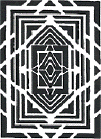
Directions for the use of this passe-partout:
measure a picture in any
rectangular or diamond shape
smaller than the passe-partout's 6 x 4 inch dimensions.
Cut out a rectangular area a little smaller than the picture
from the center of the passe-partout. Place the picture behind
this surrounding area. Alternately, don't cut the passe-partout,
simply center and mount a picture on top of it.
Also see acid-free and acid migration.
paste - See adhesives.
 pasteup - In graphic
design, two-dimensional
artwork that is produced
so that printed versions
can be produced. A pasteup is typically a composition of type
elements, illustrations,
etc., that is camera-ready when
in its final form. Although a physical image
or piece of copy is still sometimes produced, and is employed
in this process, digital
imaging has largely eliminated this step. When a camera is needed, copy is considered camera-ready
when it is in its final version, clean, flat,
and either dark ink on paper
or a pasteup.
pasteup - In graphic
design, two-dimensional
artwork that is produced
so that printed versions
can be produced. A pasteup is typically a composition of type
elements, illustrations,
etc., that is camera-ready when
in its final form. Although a physical image
or piece of copy is still sometimes produced, and is employed
in this process, digital
imaging has largely eliminated this step. When a camera is needed, copy is considered camera-ready
when it is in its final version, clean, flat,
and either dark ink on paper
or a pasteup.
Also see collage, dry transfer graphics, image capture, montage, and transferal.
pastiche - A work of art made in admitted imitation of several styles of other works. A composition of incongruous parts; a hodgepodge, pasticcio or farrago. Often a pastiche is made in order to ridicule or satirize the style of the artist it imitates.
(pr. pass-TEESH)
Example:
![]()
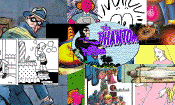
A pastiche of comic strip imagery from 1930-2000.
Also see appropriation, assemblage sculpture, bricolage, collage, construction, homage, incongruity, and parody.
pastiglia - Low relief effects produced by the brushing or controlled dripping of gesso onto a rigid surface. Traditionally, this was either painted or water gilding. Middle Ages, Renaissance, and later painters and craftsmen used this technique on moldings and other decorations, as well as within painted pictures.
(pr. pahs-TEE-lee-ə)
pastose - Thickly painted. The adjectival form of impasto.
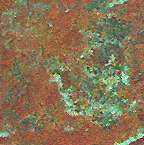
patina - A sheen or
coloration on any surface,
either unintended and produced by age or intended and produced
by simulation or stimulation,
which signifies the object's
age; also called aerugo, aes ustum, and verdigris.
Typically a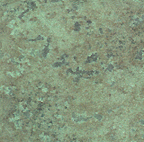 thin layer of greens (sometimes reds or blues),
usually basic copper sulfate, that
forms on copper or copper alloys,
such as bronze, as a result of oxidation and corrosion. Metal objects have naturally
acquired patinas when long buried in soil or immersed in water.
Such naturally formed patinas have come to be greatly prized.
There are many formulae for the pickles
and chemical treatments of metals which may be employed to encourage
the formation of patinas.
thin layer of greens (sometimes reds or blues),
usually basic copper sulfate, that
forms on copper or copper alloys,
such as bronze, as a result of oxidation and corrosion. Metal objects have naturally
acquired patinas when long buried in soil or immersed in water.
Such naturally formed patinas have come to be greatly prized.
There are many formulae for the pickles
and chemical treatments of metals which may be employed to encourage
the formation of patinas.
(pr. PA-tə-nə; pə-TEE-nə is also used, but many consider it a mispronunciation)
A person who produces patinas is a patineur.
Examples:
Toshiko Takaezu (American, contemporary), Three Graces, three bronze elements, each patinated to a different color, each 70 x 23 x 23 inches, Grounds For Sculpture, Hamilton, NJ.
Also see allegory and palimpsest.
patio - An outdoor space that adjoins a building, usually a residence, and usually it is paved. Typical of Spanish and Latin American architecture, a roofless inner courtyard often surrounded by a covered colonnade leading to interior rooms. Typical of Spanish and Latin American architecture.
Also see pergola and peristyle.
patriarchy and patriarchal - The social dominance of the father-- their rule as heads of families, and the preference given to males in descent and inheritance. Feminism sees patriarchy as more pervasive, and as oppressive to women. The opposite of patriarchy is matriarchy. Each is a form of sexism.
Also see androcentrism, feminist art, gender issues, political correctness, pornography, sex, world-view, xenophilia, xenophobia, and zeitgeist.
patronage - The physical or emotional support of a patron.
Also see collection and New Deal art.
pattern recognition - Awareness of forms or shapes within an image. In digital imaging, this process is computer-based.
About pattern and its recognition:
Also see closure.
paying attention - Concentration of thought upon a subject. A close or careful observing or listening. Focusing one's ability or power to concentrate mentally. Giving observant consideration. When used by a teacher, attention means "Stop, look and listen." Stop working, talking, moving, and put things down. Look toward the teacher or the student who's been called upon. "Listening" is thinking about what's being said, and speaking only when called upon. When a student needs to let a teacher know he or she needs attention, an appropriate means is to raise a hand when the speaker has stopped speaking. Raising a hand does not guarantee that a student will be called upon, although teachers should try to share attention as much as possible. When a teacher has called upon a student, all other students should lower their hands in order to pay attention to the ensuing discussion.
Quotes:
pearlescent - A kind of light that photographers in particular see in the sun's glow at dawn, citing its pearl-like qualities. This has been many photographers' favorite light in which to shoot photographs.
(pr. PəR-LES-ənt)
Also see crepuscular, day for night, and nocturne.
pectoral - An ornament or a decoration worn on the chest. A breastplate is sometimes called a pectoral. A low necklace may also be called a pectoral.
Examples:

Egypt, Lahun, Pectoral with the name of Senwosret II,
c. 1897-1878 BCE,
Dynasty 12, reigns of Senwosret II-Amenemhat III, Middle Kingdom,
gold, carnelian,
feldspar, garnet, turquoise, length of pectoral 3 1/4 inches
(8.3 cm), Metropolitan Museum of Art, NY. See Egyptian art.

Bosporan Kingdom (Black Sea Coast), in Greek
style, Necklace (Pectoral), first half of the
4th century BCE,
gold, enamel, diameter
18.4 cm, State Hermitage Museum, St. Petersburg, Russia. See
Greek art.
Also see arms and armor, costume, jewelry, and pendant.
pedagogy - The art or profession of teaching; the use of means necessary to teaching.
(pr. PE-də-gah-jee)
Also see teacher.
pedestal - A support or base as for a column or a sculpture. A support or foundation, or to provide one.
(pr. PE-də-stəl)
Examples:
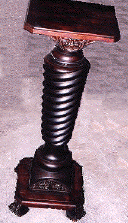
English pedestal, c. 1885, mahogany, height c. 40 inches.

Constantin Brancusi (French, born Romania,
1876-1957), Fish, 1926, polished
bronze sculpture on a metal
and wood pedestal, 93.4 x 50.2 x
50.2 cm, Tate Gallery, London.

Constantin Brancusi, Fish, 1930, gray marble, 21 x 71 x 5 1/2 inches (53.3
x 180.3 x 14 cm), on three-part pedestal of marble 5 1/8 inches
(13 cm) high, and two limestone
cylinders 13 inches (33 cm)
high and 11 inches (27.9 cm)
high x 32 1/8 inches (81.5
cm) diameter at widest point,
Museum of Modern Art, NY.
![]()
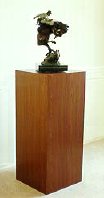
![]()
American pedestal veneered
with cherry wood, on which a sculpture is displayed.
Contemporary
American pedestals with laminated
surfaces resembling various
cut and polished stones.
Also see frame, mount, niche, pier, pillar, plinth, preparator, and vitrine.
pediment - A wide, low-pitched gable surmounting the façade of a building in the ancient Grecian style. It is formed at the end of a building by the sloping roof and the cornice. Or, a triangular element, similar to or derivative of a Grecian pediment, used widely in architecture and decoration.
(pr. PE-də-mənt)
Example:
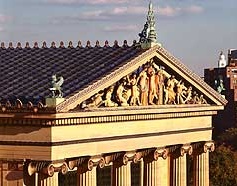
This is the pediment of the Northeast Pavilion
at the Philadelphia Museum of Art. Sculptures by Jennewein in
the pediment are collectively titled Western Civilization.
See acroterion.
Also see crocket, frieze, frontispiece, Greek art, and raking cornice.
pelike - In ancient Greek, a storage jar with two handles, a wide mouth, little or no neck, and resting on a foot. Among the other types of Greek vases are the alabastron, amphora, hydria, kantharos, krater, kyathos, kylix, lekythos, oinochoe, pithos, pyxis, and rhyton.
Examples:

Greek, South Italy, Agrigento, Red-Figure Pelike, c. 450-440 BCE,
terra cotta, Museo Archaeologico
Regionale, Palermo, Sicily. This pelike is a wine vessel
decorated with a scene from
the myth of Dionysos, god of wine. On the front of the vase,
the messenger god, Hermes, wearing a traveler's cloak, winged
hat and shoes, entrusts the baby Dionysos to Ino, who will become
his nurse. Here we see two chiton-wearing
nymphs depicted on the other side of the vase. See costume and mythology.

Greek, Apulia, South Italy, attributed to
the Darius Painter, Red-Figure Pelike, 340 - 330 BCE,
terra cotta, height
24 inches, J. Paul Getty Museum, Malibu, CA. See attributed
and red-figure.
pellicle - A thin skin or film, such as that which forms on oil paint as it dries.

pen - An implement for drawing or writing (lettering, calligraphy), consisting of a handle and a nib from which ink makes marks. Nibs can be in any of a great variety of shapes, sizes, and materials. Nibs have most commonly been made of metal, but have also been made of quill (feather), reed, bamboo, and plastics, among others.
Also see India ink or Indian ink, and sepia ink.
 pencil
- An implement for drawing or writing
(lettering), consisting of
a thin rod of graphite, colored wax,
chalk, charcoal,
or another such substance which can be sharpened to a fine point,
either encased in wood or held in
a mechanical holder. Given the importance of the human brain, eye, and hand, there may be nothing as fundamental for the production of art than the pencil.
pencil
- An implement for drawing or writing
(lettering), consisting of
a thin rod of graphite, colored wax,
chalk, charcoal,
or another such substance which can be sharpened to a fine point,
either encased in wood or held in
a mechanical holder. Given the importance of the human brain, eye, and hand, there may be nothing as fundamental for the production of art than the pencil.
Most common today are pencils which contain "leads" which are actually made of graphite, because actual lead is such a poisonous substance.
Until this form was manufactured in the nineteenth century, the term pencil referred to small, pointed brushes, and penciling referred to a painter's draftsmanship.
High quality graphite drawing
pencils are available from numerous manufacturers in nineteen
or more degrees of hardness. Most commonly, from softest to hardness,
these are: 8B, 7B, 6B, 5B, 4B, 3B, 2B, B, HB, F, H, 2H, 3H, 4H,
5H, 6H, 7H, 8H, 9H. ![]()
![]()
Typically a writing pencil is a number 2, or 2B.
Example:

Augustus John (English, 1878-1961), W.B. Yeats, 1907, pencil on paper,
35.3 x 25.3 cm, Tate Gallery, London. See portrait.

Vija Celmins (Latvian-American, 1938/39-,
Untitled (Ocean), 1970, pencil on paper, 14 1/8 x 18 7/8 inches (36 x 48
cm), Museum of Modern Art, NY. See seascape.
Other resources about
 pencils:
pencils:
Also see eraser, stain removal, and study.
pencil sharpener - For utility, common wood-and-graphite pencils must be pointed — sharpened. The device with which this is accomplished must be among an artist's supplies.
A sharp knife may suffice; but for control, speed, and safety, there are a number of mechanical sharpeners that present advantages.
For an art classroom, or any other studio in which a great many pencils must be sharpened, no sharpener surpasses a high-volume commercial electric pencil sharpener. One such machine with a heavy-duty motor is Hunt Corporation's "Boston 41" model. The cutting action stops automatically when the point is made. The Boston 41 also automatically shuts the motor off before overheating, and resets the switch when the motor is cool. It has two solid steel cutters with 30 cutting edges, and its adjustable guide sharpens various diameter pencils. It also has an extra large shavings receptacle.
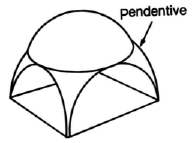
pendentive - A concave, triangular piece of masonry (a triangle section of a hemisphere), four of which provide the transition from a square area to the circular base of a covering dome. Although they appear to be hanging (pendant) from the dome, they in fact support it.
Related link:
The Glossary of Medieval Art and Architecture defines pendentive and provides another illustration.

pentagon - A closed two-dimensional shape (polygon) bounded by five straight-line segments. The formula with which to find an equilateral pentagon's area is 1.7205 times the length of one side squared. Also see mathematics and regular.
pentimento - An underlying image in a painting, as an earlier painting, a part of a painting, or original drawing, that shows through, usually when the top layer of paint has been worn or become transparent with age. These images which were supposed to be hidden often appear like ghosts — not entirely solid. Many result from a painter's decision that a nearly finished picture needs to be altered, but the new passage is made with too thin a layer of paint. Pentimento is Italian for "repentance". The plural form is pentimenti.
Also see infrared reflectography (IR), overpainting, underpainting, and palimpsest.
penumbra - A partial shadow
between regions of  complete shadow and
complete illumination.
From the word umbra, which means shadow. The penumbra on
the cyan sphere
you see here is located in two areas: between the brightest
and the darkest areas, and
also to the lower left of the darkest shadow. This latter area
is the least obvious aspect to the shadowing on this sphere, because
its presence is counter-intuitive, but when rendered,
adds to the illusion of the
sphere's three-dimensionality.
complete shadow and
complete illumination.
From the word umbra, which means shadow. The penumbra on
the cyan sphere
you see here is located in two areas: between the brightest
and the darkest areas, and
also to the lower left of the darkest shadow. This latter area
is the least obvious aspect to the shadowing on this sphere, because
its presence is counter-intuitive, but when rendered,
adds to the illusion of the
sphere's three-dimensionality.
(pr. pə-NUM-brə)
Examples:
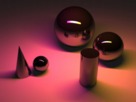
Emmanuel Viale (French, c. 1979-) one of
four digital images in a
series titled Penumbra, depicting highly reflective
forms — three spheres, a cones
and a cylinder — objects resting
on what would be a white plane, as seen under
colored lights.
Also see chiaroscuro, light, and shading.
People's Republic of China - A period of Chinese history which began with the success of the Communist revolution in 1949. An important phase in this period was the Cultural Revolution, which lasted from 1966-1976. This was a comprehensive reform movement initiated by Mao Zedong in 1965 to eliminate counterrevolutionary elements in China's institutions and leadership. The People's Republic of China's most prominent style has been its official style, socialist realism, although this has lessened since the encouragement of capitalistic enterprises began in the 1980s.
The People's Republic period of Chinese history overlaps with that of the Republic of China, which was driven from mainland China in 1949, but has flourished as a separate country since that time on the island of Taiwan.
Examples of art made in the people's Republic of China:
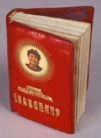
China, Culture Cultural Revolution period, Red Book, 1969, book with red cover, picture of Mao Zedong, text: "Long Live Chairman Mao's Thought," 11.0 x 2.0 x 8.5 cm, Burke Museum, U of WA, Seattle. Collections of Mao's works were printed in many editions and in huge numbers, third in circulation only to the Bible and the Koran. People carried Mao's works in public and studied the contents.
.
The following posters were produced in China during the Cultural Revolution:
![]()

![]()
China, Chairman Mao Zedong, poster, Burke Museum, U of WA, Seattle. See portrait.

China, Mao is the Red Sun, "Respectfully wish a
long life without end to the reddest, reddest sun in our hearts:
Chairman Mao," poster,
Burke Museum, U of WA, Seattle. See circle.

China, Man on the front of a train, above a Mao slogan: "Forcefully aid agriculture," poster, Burke Museum, U of WA, Seattle.

China, Man driving a tractor holds up a copy of Mao's Red Book, above a Mao quote: "Continuous revolution always going forward," poster,
Burke Museum, U of WA, Seattle.
![]()
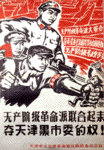
![]()
China, Three Against the Enemy, poster, Burke Museum, U of WA, Seattle.

China, Schoolchildren devote themselves to Mao's writings,
poster, Burke
Museum, U of WA, Seattle.
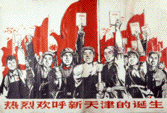
China, Masses of the People March in support of the
revolution, holding the red flag and the red book of Mao's writings,
poster, Burke
Museum, U of WA, Seattle.
Related links:
Also see propaganda.
peplos - In ancient Greece, a woollen garment worn by women, also called the Doric chiton, often open down one side and fastened on both shoulders.
Also see chlamys, costume, himation, and mantle.
percept - A piece of sensory data received by the brain. In other words, a mental impression of something perceived by the senses. A percept is the basic component in the formation of concepts.
Also see déjà vu, knowledge, and memory.
perception - The process of becoming aware through sight, sound, taste, smell, or touch; detection.
"Perceptible," applies to what can be discerned to a minimal extent, and it belongs to a family of "detectable" synonyms. "Appreciable" means capable of being perceived or measured (see appreciate), and applies to what is highly noticeable or definitely measurable. "Sensible" refers to something that is clearly perceived (see sense). "Palpable" applies to something that, if it doesn't have actual physical substance, is nevertheless quite noticeable via the senses ("a palpable chill in the air"). "Tangible" is used for something capable of being handled or grasped, either physically and mentally.
Quote:
Other resources about perception:
Also see attention, colorblindness, consciousness, context, definition, déjà vu, gestalt, irony, knowledge, memory, mirror, night blindness or nyctalopia, obsession, ophthalmology, Op Art, optical, optical illusion, optical mixing, photoreceptors, point of view, reversible, seeing, subliminal message or subliminal advertising, trompe l'oeil, and ultraviolet.
Perceptual Abstraction - A name for what is more often called Op Art.
perfect and perfection - Perfect is the quality of being without defect or blemish; accurate, exact; complete, utter; absolute. Or, completely suited for a particular purpose. Perfection is the condition of being perfect.
How to measure or assess it — the degree to which perfection has or hasn't been achieved? This may be possible in the sciences, but in the arts, perfection cannot be objectively judged. Only a subjective judgment can be made.
Is perfection a worthy standard for artistic achievement? Embracing perfection as a goal is one of the classic blocks to creativity. Because it is so self-defeating, perfection is not one of the standards a productive artist pursues, and one that art critics, collectors, and educators pursue to their peril!
Quote:
Also see analysis, art criticism, aesthetics, bad art, beauty, craftsmanship, ideal, idealization, idealized, likeness, master, mirror, motivation, mutable, nude, objectivity, obsession, praise, quality, quality control, quality of life, quotations, standards, sublime, subjectivity, unique, and virtual.
performance art - Art in which works in any of a variety of media are executed premeditated before a live audience. Although this might appear to be theater, theatrical performances present illusions of events, while performance art presents actual events as art. One of the things setting postmodernism apart from modernism is its acceptance of aspects of theater. Performance elements surfaced in a number of conceptual art movements of the 1960s, including: Fluxus, Happenings, body art, process art, street works, etc. The 1980s saw the emergence of performance artists like David Byrne (American) and Laurie Anderson (American, 1947-), who had each been students of visual art, but whose work gradually incorporated voice, music, costumes, projected image, stage lighting, etc.
Example:
Laurie Anderson (American, 1947-), Oh, Superman, 1981.
Other resources concerning performance art:
Also see content, dance, interdisciplinary, narrative art, and new media.
pergola - An arbor or a walkway lined with columns supporting a roof of trelliswork upon which vines and other plants are trained to grow.
Examples:
![]()
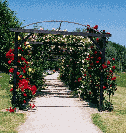
![]()
French, The Rose Pergola at the Ville d'Estavayer-le-Lac, near Lac de Neuchâtel,
France.

American, The Richard E. Danielson Vine Pergola
is festooned with tropical flowering vines, Fairchild Tropical Garden, Coral Gables (Miami),
FL.
Also see peristyle.
perimeter - The outer edges of a closed two-dimensional shape, or the length of those edges. The perimeter of a circle is its circumference.
period - An interval of time characterized by the prevalence of a specified culture, ideology, or technology, or regarded as a distinct phase in the development of the work of an artist, or a style or movement. In punctuation, a dot signifying a full stop.
Also see isms and -ism and periodicity.
periodicity - The quality of being periodic — of recurrence at regular intervals; organized as a sequence of intervals or period (schools, movement, styles, etc.), as studies of art history commonly are. It is being discussed when one hears about stylistic pendulum swinging. Although such structure allows for the making of generalizations which are needed in developing a framework for the understanding of great spans of cultural history, awareness of variations tends to be lost. Unless the exceptions are studied, a less robust understanding of history results. This is one argument against the canon, and in support of multiculturalism.
Also see animation, archaeology, chronology, concatenation, horology, interdisciplinary, moiré, music, rhythm, science and art, time, and tradition.
peripheral vision - Perception near the outer edges of the retina.
periphrastic - Using many words when few would do; verbose; round-about; circumlocutory. An attribute ascribed to some of the worst art writing.
Also see art criticism and art history.
peripteral - In architecture, a style of building in which the main structure is surrounded by a colonnade.
(pr. pər-IP-tə-rəl)
Also see arcade, balcony, gallery, and peristyle.
peristyle - A court enclosed on all sides by a colonnade, such as occurs in ancient Greek and Roman temples and medieval cloisters. Or, a series of columns surrounding a building or enclosing a court. Also see arcade and peripteral.
permanence, permanent - Permanence is the quality of lasting into the far distant future. Something is permanent when it is fully expected to last many generations. There is a certain hubris in claiming anything about the future. Things can last as briefly as a moment before they are gone. Others last a few days, weeks, months or years — to varying degrees, these are all temporary, fragile in some way or other. Music, dance, and theater were once considered utterly transitory. With recording equipment, we have ever more commonly excellent documentation of such performance works. Many things that might have been permanent have been damaged, destroyed, or otherwise lost due to either natural or human causes. The natural category includes fires, floods, earthquakes, and other storms, insects, light, mold, and other problematic substances. Manmade disasters include wars, vandalism, accidents, pollution, neglect, and even the daily gentle touches of too numerous admirers. Permanence is an important issue to many in the art world. We are concerned that art media be permanent so that works can last if taken care of reasonably well; so we seek out permanent pigments, acid-free papers, and other sturdy materials, some that contain or seal surfaces from atmospheric and other forces. Museums speak of works in their collections being in their "permanent collections." Buyers of very expensive works think at least partly of their collections as investments or as gifts to posterity.
Quote:
Also see art conservation, art restoration, immutable, installation, Masonite, kiss of death, time, and vanitas.
permanent collection - Those objects that are owned by a museum.
Also see accession, catalogue, collection, deaccession, and donation.
permanent pigment and color permanence - Any pigment which can be expected to last or remain without essential change — little likely to deteriorate under certain atmospheric conditions, in normal light or in proximity to other colors. Color permanence refers to a pigment's lasting power. Tubes and other containers of paint are sometimes labeled with a code indicating a color's degree of permanence:
|
letter code |
degree of color permanence |
|
AA |
highest |
|
A |
standard |
|
B |
less than permanent, though fairly durable |
|
C |
fugitive |
Also see acid-free, archival image, and fugitive colors.
perpendicular - Intersecting at or forming right angles. Because humans tend to describe angles as they relate to the horizontal plane, perpendicular often means vertical.
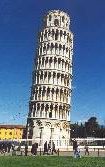
The principle reason for the fame of this
campanile in Pisa, Italy,
is that it is not perpendicular. Because it is about 12º
away from vertical, it is commonly known as the Leaning Tower
of Pisa. Built in 1174, this tower
has eight stories of arcades,
with a diameter of 52 feet,
its original height
was 151 feet 3 inches. The belfry was added in 1350.
Also see straight.
Persian art - See Islamic and Mesopotamian art.
persistence of vision - Retention in the brain for a fraction of a second of whatever the eye has seen; causes a rapid succession of images to merge one into the next, producing the illusion of continuous change and motion in media such as cinema, video, and computer animations.
Example:

John Ayrton Paris (Scottish), a physician,
The Bird in a Cage, 1825, a small circular disk of paper,
a bird was drawn on one side, and the cage on the other. This
is suspended between two pieces of string. When the disk is twirling,
the viewer sees a bird in a cage. Paris called this toy a "thaumatrope"
in his Philosophy in Sport Made Science in Earnest, 1826.
The British scientists William Hyde Wollaston (1766-1828), Charles
Babbage (1792-1871), and Sir William Herschel (1738-1822) each
devised similar inventions.
Related link:
Also see afterimage.
personification - Representation of something inanimate or abstract as having personality or the qualities, thoughts, or movements of a living human being. For example, Liberty is portrayed as a woman raising a torch. This is also called prosopopeia.
Also see allegory, anthropomorphism, content, sign, signature, and symbol.
perspective - The technique artists use to project an illusion of the three-dimensional world onto a two-dimensional surface. Perspective helps to create a sense of depth — of receding space. Fundamental techniques used to achieve perspective are: controlling variation between sizes of depicted subjects, overlapping some of them, and placing those that are on the depicted ground as lower when nearer and higher when deeper. In addition, there are three major types of perspective: aerial perspective, herringbone perspective, and linear perspective.
Example:

Giotto di Bondone (Italian, Florentine, 1266/76-1337).
This is one of two views Giotto painted side-by-side
using herringbone perspective. These scenes are interiors
of what appear to be sacristries or a choir, in perfect perspective.
The effect is so realistic that we feel we are looking into actual
rooms. Our gaze moves beyond the ogival arch to the cross-vault
of each room, and thence to the Gothic mullioned window. That
the two symmetrical chapels appear to have approximately the
same vanishing point is an astonishing anticipation of the fifteenth-century
perspective system. Though their significance was once ignored,
these small scenes are now recognized as an extremely important
phase in the development of Giotto's conception of pictorial
space. See trecento.
Internet resources concerned with perspective:
Also see bird's-eye view, chiaroscuro, direction, di sotto in sù, fish-eye lens, optical illusion, panorama, point of view, wide-angle, wireframe, and worm's-eye view.
perspicacious and perspicacity - Having or showing penetrating thinking skills; clear-sighted. Such an acuteness of perception is perspicacity. (pron. pər-spə-KAY-shəs, pər-spə-KA-sə-tee) Not to be confused with perspicuous. One easy way to keep out of trouble is to think of "perspicUous" as the "U" word, and remember that it means "Understandable" — in contrast to the "A" word, "perspicAcious," that means "Astute." Both words come directly from Latin adjectives that mean the same thing they do: "perspicuous" from "perspicuus," and "perspicacious" from "perspicax."
perspicuous and perspicuity - Clearly expressed; lucid; easy to understand, especially because of clarity and precision of presentation. The quality of being perspicuous is perspicuity. (pron. pr'spik"yoo-es, pr'spe-kyoo"e-tee) Not to be confused with perspicacious. One easy way to keep out of trouble is to think of "perspicUous" as the "U" word, and remember that it means "Understandable" — in contrast to the "A" word, "perspicAcious," that means "Astute." Both words come directly from Latin adjectives that mean the same thing they do: "perspicuous" is based on Latin "perspicere," meaning "to see through," so that which is perspicuous is clear and understandable. "perspicacious" from "perspicax."
![]()

![]()
pestle - A tool used to crush or grind substances in a mortar. Before many artists' materials were manufactured and made commercially available, artists and their assistants produced paints and other media from raw materials, grinding many of them to prepare colorants, binders, glazes, investments, etc.
If you're missing your pestle, consider improvising with a river rock — well rounded by long exposure to the smoothing action of flowing water. Look for a thin, oblong stone. Also see trituration.
petroglyph - An image engraved or drawn on rock, especially one made by prehistoric people.
Examples:

Russia, Lake Onega, Carved
Petroglyph (fragment),
4th-3rd millennium BCE,
granite, 240 x 308 cm, Hermitage
Museum, St. Petersburg, Russia. See Stone Age.
Zuni, New Mexico, Bighorn petroglyph, as photographed in 1986.

Fremont warriors guard a canyon near McKee
Spring, Dinosaur National Monument, Utah, petroglyph.
.
Other resources on petroglyphs:
Also see glyph, hieroglyph, icon, ideogram, lettering, logo, pictograph, text, and typography.
pewter - Any of various alloys
with tin as the main component;
bright modern pewter contains
6-7% antimony and 1-2% copper; the dull metal
of the past contained up to 25% copper, antimony, or lead.
Sometimes sculptures
described as made of lead have actually been made of such an alloy
as this. Caution: contact with lead can contaminate food with
poison.
(pr. PYOO-tər)
Examples:
![]()

![]()
A variety of traditional
American pewter dishes.
https://inform.quest/_art